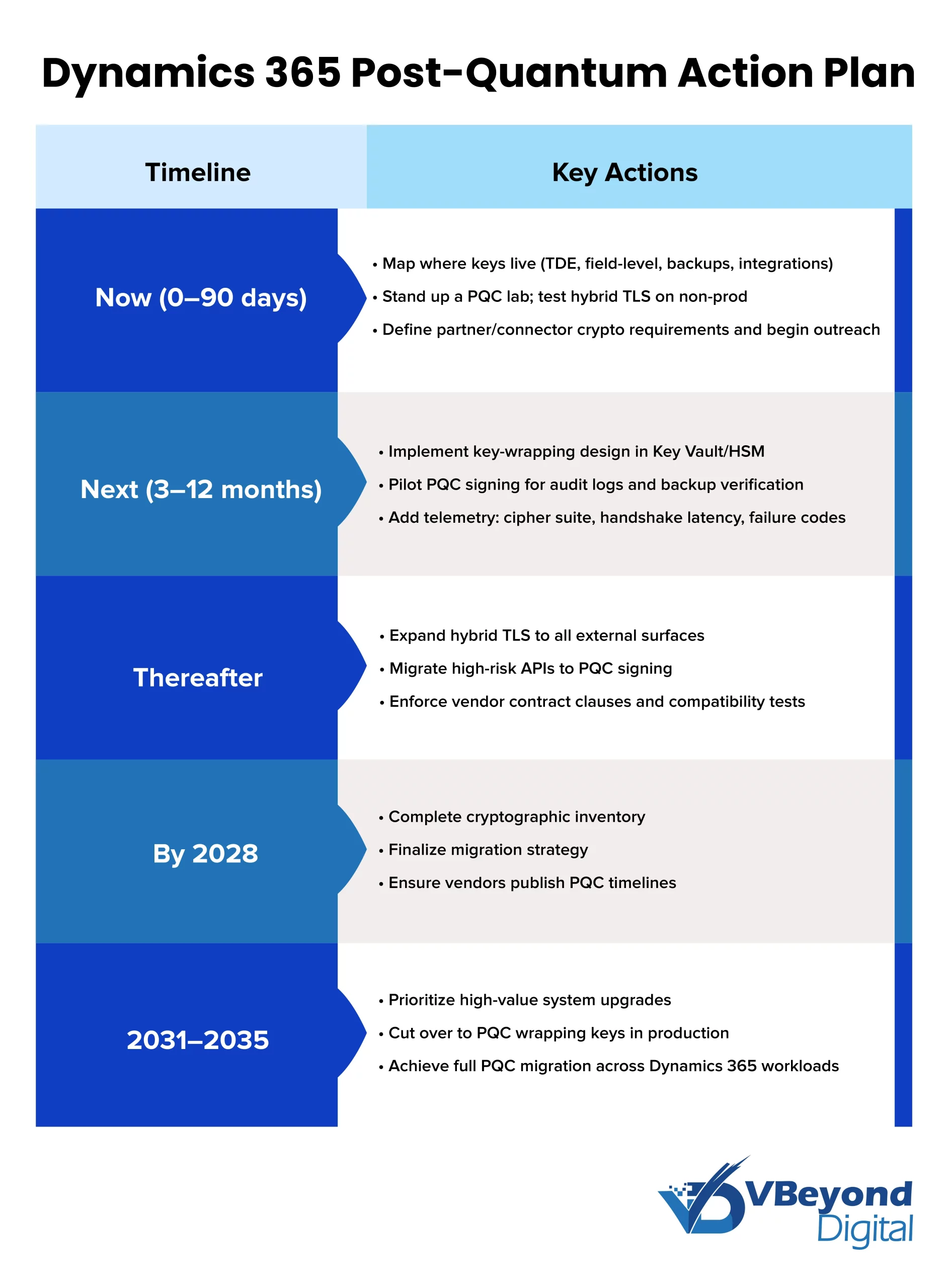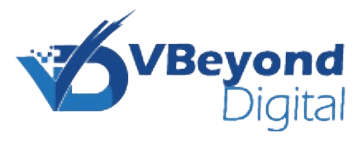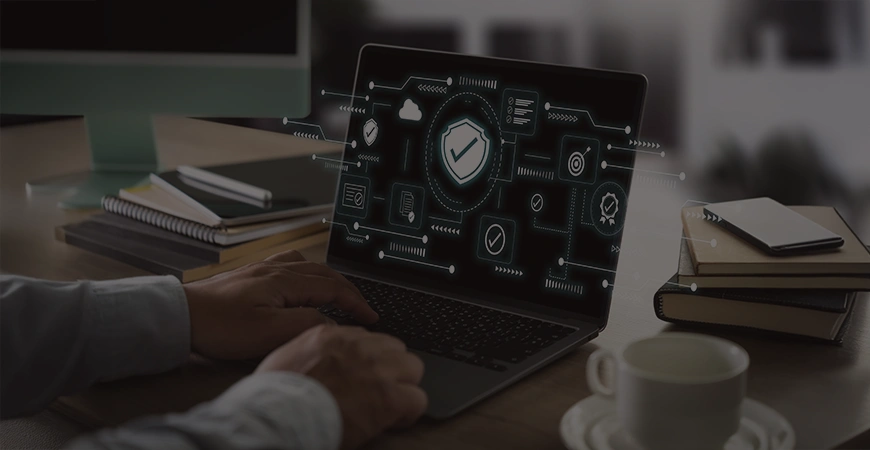Preparing for Post-Quantum Security in Dynamics 365: A Practical Guide
Section
Quantum computing will break today’s encryption, putting Dynamics 365 data at risk. With new NIST post-quantum standards and global migration timelines, organizations must act now. This guide shows how to build crypto-agility, pilot hybrid TLS, secure keys in Azure, and plan phased rollouts so Dynamics 365 stays secure, compliant, and ready for the quantum era.
• Quantum risk is real: RSA and elliptic-curve encryption are on a countdown as quantum computing advances, making early preparation essential.
• Standards are here: With NIST’s 2024 post-quantum cryptography standards and UK NCSC’s migration timeline, organizations now have a roadmap for secure transition.
• Dynamics 365 in focus: Securing data, APIs, backups, and integrations in Dynamics 365 requires a phased, hybrid approach that balances business continuity with future-proof security.
• Action today, resilience tomorrow: Building crypto-agility, piloting PQC, and embedding governance now will protect sensitive records and maintain compliance well before full migration deadlines.
Quantum computing is set to upend today’s cryptography, putting RSA and elliptic-curve protections on a countdown. For complex enterprise platforms like Dynamics 365, that means years of encrypted records, backups, and integrations could be exposed once a capable machine arrives. The transformation is still far enough on the horizon but real, and preparation needs to start before the technology matures.
NIST’s release of new Federal Information Processing Standards in August 2024 marks the beginning of a new cryptographic era. For the first time, organizations now have formal quantum-resistant standards to guide their long-term security planning. These standards represent years of rigorous evaluation and provide a clear path for businesses to start preparing for the post-quantum world.
The UK’s National Cyber Security Centre has established a comprehensive three-phase migration timeline that serves as a global benchmark for organizational preparedness. By 2028, organizations must complete cryptographic asset discovery and develop migration strategies. High-priority system upgrades must occur between 2028 and 2031, with full migration mandated by 2035. This timeline acknowledges the complexity of enterprise cryptographic dependencies while providing sufficient lead time for thorough planning and execution.
Strategic Roadmap and Governance
Defining a Crypto-Agile Framework
Quantum-ready security means the system can change cryptography without changing applications. Place crypto decisions behind clear interfaces so teams switch methods through configuration and policy, not code edits. Bring keys and policy into one governed plane with Key Vault plus HSMs for rotation, auditing, and consistent controls across both today’s and Post-Quantum Cryptography (PQC) algorithms. Expect years of coexistence: design endpoints that can negotiate classical and quantum-safe options, fall back safely when needed, and record what was negotiated for compliance and troubleshooting. The result is an estate that absorbs standard updates and vendor changes while product delivery keeps moving.
Phased Migration Plan
Set direction with facts, not assumptions. By 2025, complete a cryptographic inventory that ties algorithms to the data they protect and the services they enable; this becomes the prioritization map. From 2025–2028, run representative pilots on lower-risk workloads to surface performance effects, compatibility gaps, and operational procedures before exposing core systems. Then scale deliberately toward 2035, sequencing rollouts by business criticality and integration complexity so uptime and customer experience remain stable. If risk or regulation pushes you faster, widen pilots and shorten feedback cycles, but gate each step on measurable security outcomes and service reliability.
Governance and Leadership
Treat the migration project as enterprise change. The CIO anchors strategy and investment, the CISO defines risk posture and control objectives, and IT/operations drive execution across platforms and partners. Use a single steering rhythm that tracks three essentials: reduction of quantum-vulnerable exposure, readiness of critical vendors and integrations, and user-visible performance and reliability. With clear ownership and a shared scorecard, the organization advances in lockstep, reducing present risk while building the capacity to adapt as standards and ecosystems evolve.
Treat the migration project as enterprise change. The CIO anchors strategy and investment, the CISO defines risk posture and control objectives, and IT/operations drive execution across platforms and partners. Use a single steering rhythm that tracks three essentials: reduction of quantum-vulnerable exposure, readiness of critical vendors and integrations, and user-visible performance and reliability. With clear ownership and a shared scorecard, the organization advances in lockstep, reducing present risk while building the capacity to adapt as standards and ecosystems evolve.
Schedule your consultation on migrating to Dynamics 365 Business Central.
Technical Preparation and Pilot
Test Environment Setup
Microsoft has made post-quantum cryptography capabilities available through Windows Insider Build 27852 and higher, providing early access to ML-KEM and ML-DSA implementations. These builds integrate PQC support into the Cryptography API: Next Generation (CNG) framework, enabling developers to experiment with quantum-resistant algorithms in controlled environments. Use the environment to see how endpoints negotiate hybrid options, what monitoring actually captures, and where toolchains or agents need updates. Treat this like product discovery: document what breaks, what slows down, and what configuration changes remove friction, then fold those lessons into your rollout plan.
Key Management in Azure
Make key management the control plane for change. Centralize policies, rotation, access, and audit in Azure Key Vault and Managed HSM so classical and quantum-safe keys can live side by side without policy drift. Assume a long hybrid period and write clear runbooks for creation, backup, restore, and retirement of both key types. Keep a close eye on platform roadmap notes and gate adoption on what is officially supported in your tenant rather than assumptions from the lab. When in doubt, design for portability so keys and policies can move without rewriting applications.
Securing Communications
Prioritize the paths that matter most: public TLS termination, administrator and VPN access, and system-to-system APIs. Enable hybrid TLS where possible so modern clients gain quantum-safe protection while older endpoints continue to connect and capture the negotiated result in logs for compliance and troubleshooting. Expect larger handshakes and some added latency; validate the impact under realistic load and update capacity models accordingly. In parallel, align PKI and certificate practices with your target algorithms so trust chains, issuance workflows, and renewal automation don’t become bottlenecks. Finish each pilot with clear success criteria such as interoperability, performance envelope, and observability, and promote only what meets the bar.
Integration into Dynamics 365 Workloads
Data at Rest
Make PQC a wrapper, not a rewrite. Keep SQL Server Transparent Data Encryption and Azure Disk Encryption for speed, and design key-wrapping so database encryption keys can be protected by quantum-safe methods as they become supported. Centralize customer-managed keys in Azure Key Vault/Managed HSM, align rotation and access policies, and document how you’ll swap the wrapping keys later with no schema changes. Upgrade audit and metadata signing paths to quantum-resistant options on your timeline; integrity of historical records matters as much as confidentiality. Finally, bring backups into scope: encrypt long-retention archives with PQC-ready key plans and verify restores with upgraded signatures.
Data at Transit
Harden the edges first. Enable hybrid TLS on internet-facing endpoints so modern clients negotiate quantum-safe options while legacy traffic still connects. For Dynamics 365 front doors (Azure Front Door/App Gateway), bake in health checks that confirm the negotiated suite and log it for compliance. Move admin/VPN and service-to-service APIs into the pilot ring early; they carry the highest risk. As you shift API authentication, plan the move from classical JWT signing to quantum-safe signatures with clear fallback and a cutover window. Expect bigger handshakes and a touch more latency—run load tests, update capacity models, and watch connection setup times in production telemetry.
External Integrations
Treat partners as part of your cryptography. Publish minimum crypto requirements for ISVs, connectors, Logic Apps, and custom integrations, including supported algorithms, hybrid expectations, and rollback rules. Maintain a compatibility matrix across key interfaces (ERP feeds, finance reporting, customer portals) and gate releases on interop tests that include handshake negotiation and certificate validation. Fold vendor readiness into procurement and renewals; contracts should specify PQC timelines, support levels, and evidence of testing.
Dynamics 365 Action Plan
Note: The timeline below is indicative, based on public benchmarks (e.g., the UK NCSC’s PQC migration roadmap—discovery by 2028, priority upgrades by 2031, full migration by 2035—and the NSA’s CNSA 2.0 transition milestones). Actual pacing will vary by sector, regulatory obligations, legacy footprint, and organization size.
Now (0–90 days)
- Map where keys live: TDE, field-level crypto, backups, integrations.
- Stand up a PQC lab; test hybrid TLS on a non-prod front door and API.
- Define partner/connector crypto requirements and start the outreach.
Next (3–12 months)
- Implement key-wrapping design with Key Vault/HSM; document swap procedures.
- Pilot PQC signing for audit logs and backup verification.
- Add telemetry: negotiated cipher suite, handshake size/latency, failure codes.
Thereafter
- Expand hybrid TLS to all external surfaces; migrate high-risk APIs to PQC signing.
- Enforce vendor contract clauses; block releases that fail the compatibility matrix.
- Schedule the production swap of wrapping keys when platform support is ready.
This keeps Dynamics 365 running fast today, while laying clean tracks for a PQC cutover when the ecosystem is ready.

Skills, Training, and Change Management
Begin by building confidence before you change anything in production. Give engineers and architects a shared baseline on post-quantum concepts, how Microsoft’s guidance is evolving, and what that means inside Azure and Dynamics 365. Then move quickly to hands-on labs in a safe tenant so teams practice the real motions: cipher negotiation, certificate updates, key handling, and rollout/rollback, without risk.
Incorporate these learnings into the delivery pipeline rather than treating them as side projects. Expand CI/CD to exercise multiple cryptographic options, watch for performance drift, and verify end-to-end that tokens, certificates, and policies behave as intended. Ensure deployments can cope with larger certificates and longer key generation, and that observability captures what was actually negotiated so issues are visible and not based on guesswork.
Update incident response to reflect new failure modes. Playbooks should cover downgrade attempts, hybrid-suite mismatches, key-wrap or rotation errors, and suspected PQC key compromise, with clear containment and recovery steps. Tabletop exercises turn these scenarios into muscle memory and surface tooling or process gaps before they matter.
Treat the shift as organizational change, not a backend tweak. Explain why the migration reduces risk, set expectations on cost and timing, and measure progress with a small set of outcomes: shrinking quantum-vulnerable exposure, growing vendor/partner readiness, and steady user-visible reliability and latency. Where bandwidth is limited or decisions are high stakes, bring in specialist partners to accelerate architecture reviews and pilot design, then transition ownership back to the internal teams that will run the program day to day.
Conclusion
Post-quantum cryptography migration represents one of the most significant security transformations in modern computing history, with significant implications for Dynamics 365 environments containing sensitive customer and business data. The convergence of NIST standardization, regulatory mandates, and quantum computing advancement creates an urgent imperative for proactive preparation and systematic implementation of quantum-resistant security measures.
The business outcomes justify substantial investment in post-quantum migration including protection of valuable CRM data, compliance with evolving regulatory requirements, and maintenance of customer confidence in secure data handling practices. Organizations that delay migration risk significant competitive disadvantages, regulatory penalties, and catastrophic data exposure when quantum computers achieve cryptanalytic capability within the next decade.
The quantum computing revolution will reshape cybersecurity fundamentals, but organizations that begin post-quantum preparation today will be positioned to thrive in the quantum-enabled future while maintaining the security, compliance, and performance standards essential for successful Dynamics 365 operations.
FAQs (Frequently Asked Question)
Azure Cost Management is a unified portal that collects consumption data, budgets, forecasts, and anomaly alerts. It lets you monitor resource-level spending across subscriptions, resource groups, and management groups. Built-in budgets and alerts integrate with Logic Apps for threshold notifications, enabling continuous cost tracking instead of relying on end-of-month invoices.
Effective FinOps budgeting uses rolling forecasts to update plans more frequently than quarterly or annual cycles. Teams collaborate by assigning budget ownership to individual business units, triggering notifications when spending near thresholds. This approach shortens planning cycles and embeds financial accountability across technical and finance teams.
The Azure FinOps toolkit for Power BI provides prebuilt report templates, such as Cost Summary, Rate Optimization, and Data Ingestion, that connect directly to ADLS Gen2 datasets. Power BI connects via Azure Data Explorer or the Cost Management connector to automate spend analysis, correlate usage with budget thresholds, and accelerate chargeback reporting.
Migrating from an Enterprise Agreement (EA) to a Microsoft Customer Agreement (MCA) requires updating scripts to call the new Cost Management APIs authenticated via Azure AD tokens instead of static API keys. Teams must verify billing account scopes, reconfigure export definitions, update role assignments, and validate subscription mappings to maintain uninterrupted, compliant exports.
Azure Data Lake Storage Gen2’s hierarchical namespace offers file-system semantics that accelerate query performance and folder-level lifecycle rules for cost data storage. It also supports POSIX-style access control lists (ACLs), enabling granular permissions on directories and files for audit-grade governance and parallel Power BI report refreshes.




